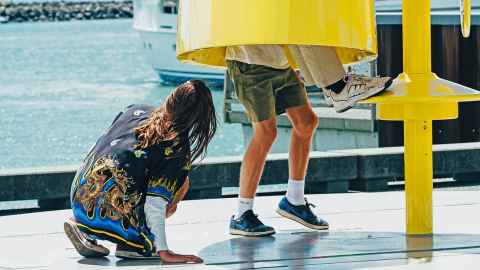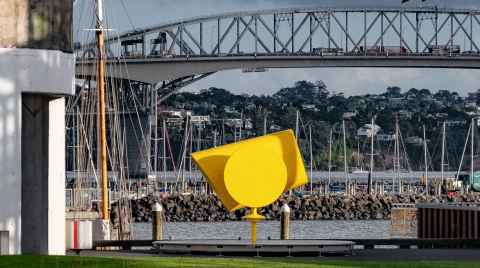Harnessing the sun and making rainbows
18 November 2019
A team made up of staff and alumni from the University of Auckland has recently been awarded a major design award for an interactive art installation that makes rainbows.

The appropriately titled, Rainbow Machine, was installed at Silo Park for the first time in January this year. Since then it has been to MOTAT and is now back at Silo Park until Saturday 8 February 2020.
Rainbow Machines gives children and adults the chance to harness natural light, and experience an ephemeral moment in the saturated colour of rainbows.
It was designed by Dr Sarosh Mulla, lecturer at the School of Architecture and Planning, Elam post-graduate, sculptor and designer, Shahriar Asdollah-Zadeh, and Patrick Loo, an architect who has recently completed a masters in commercialisation and entrepreneurship at the University.
The team of three studied together at CAI during their undergraduate years: Dr Mulla and Mr Loo studied at the School of Architecture and Planning and Mr Asdollah-Zadeh at Elam. “All of us have a history of working on projects that challenge our usual disciplinary boundaries, but Rainbow Machine was the biggest project we’ve worked on together,” says Dr Mulla.
“Our friendship and collaborative creative process began forming in those years and has continued on into our professional design practices,” adds Mr Asdollah-Zadeh. “Working as an artist project team on Rainbow Machine for Auckland Council was an amazing experience.”
The design bridges the gap between contemporary play-space design and interactive experience and provides a simple way for people of all ages and abilities to enjoy one of nature’s most intriguing phenomena.
Rainbow Machine was awarded a Purple Pin from DINZ (Design Institute New Zealand) this year in the Spatial class. Previous Purple Pin winners in the same category include the Waterview Connection (2018), the space in the National Library where Te Tiriti o Waitangi is displayed (2017) and the pink bicycle path, Te Ara I Whiti / The Lightpath (which is also part of the public art collection). Rainbow Machine also won three Gold Pins in three categories within the same class.
All three are attracted to unusual projects and exhibitions that demand innovative solutions. “I enjoy working on installations, artworks and more traditional pieces of architecture because they all offer different problems to solve and creative opportunities,” says Dr Mulla.
Rainbow Machine allows participants to playfully perceive and capture the essence of light and its colour spectrum by turning the cone toward the sun. Its form is redolent of the types of mechanical devices often found in children's playgrounds, with elements (such as the wheels) positioned and shaped to encourage curiosity and intuitive interaction. “Rainbow Machine is an immersive experience of natural light through interactive play,” says Mr Asdollah-Zadeh.
The cone position is scaled for the child, but also accessible for their caregivers, and painted a vibrant yellow, picking up on the colour we associate with sun, as well as happiness and play.
The artist team were inspired by the studio of Olafur Eliasson. His light installation artworks, which span several decades, were a point of research. “We always wanted to do something with rainbows and the colour spectrum and when we came across Eliasson’s works, we knew we were working with the right medium – light,” he says.
The team of designers, artists and architects had been approached by Auckland Council on behalf of the Waitematā Local Board, which was looking to create opportunities for fun, discovery and the unexpected in the city centre, for children and their families.
Scientists from Callaghan Innovation brought their expertise to the design of the optical module from which rainbow spectra are formed; the module contains eight custom-made lenses to refract light. Rainbow Machine connects design, art, science, engineering and innovation. “We’re fortunate to have had the chance to collaborate with an impressive group of experts from physicists, fabricators and engineers in order to bring the project to life,” says Patrick Loo.
Rainbow Machine is a mobile structure that can be programmed as a site-specific installation in different locations. “The design bridges the gap between contemporary play-space design and interactive experience and provides a simple way for people of all ages and abilities to enjoy one of nature’s most intriguing phenomena,” says Dr Mulla.
The DINZ judges said of the work: “It did not exist in the world until now. It is its own language and typology. This ray of sunshine injects joy into space, in fact, it creates its own spatial dynamic wherever it goes.”

Media contact
Margo White I Media adviser
DDI 09 923 5504
Mob 021 926 408
Email margo.white@auckland.ac.nz